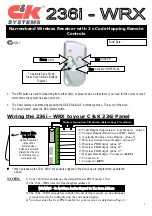
©1995 Hamtronics, Inc.; Hilton NY; USA. All rights reserved. Hamtronics is a registered trademark. Revised: 10/23/02
-Page 1-
FUNCTIONAL DESCRIPTION.
The R100 is a commercial-grade
single-channel vhf fm receiver avail-
able in models for various bands, both
in kit form and factory wired and
tested.
The R100 features a front end
with low-noise dual gate fet's and tri-
ple-tuned circuits for excellent sensi-
tivity and rejection of out-of-band
interference. It has an 8-pole crystal
filter with steep skirts
plus a ceramic
filter for close channel spacing or re-
peater operation. The i-f selectivity,
for instance, is down over 100dB at
±12 kHz away from the carrier, which
is 40-50 dB better than most trans-
ceivers.
A new positive -acting, wide-range
squelch circuit locks onto fading sig-
nals. The R100 has output terminals
for low-level squelched audio and dis-
criminator audio as well as speaker
audio and a COS logic signal from the
squelch circuit.
ASSEMBLY.
General Information.
M
Note that vhf equipment requires
precise construction using short, direct
leads. Seat parts as close to the board
as possible without over-stressing the
leads.
Be sure to follow instructions as
given and don't arbitrarily do things
differently.
When installing resistors and di-
odes that are mounted vertically, be
sure to orient the body as shown by
large circles in parts location dia-
gram.
M
Static handling precautions are re-
quired for the fet's. The small geometry
and high impedances make FET's heat
and static sensitive; so be careful. It is
good to discharge your hand to a
grounded metal object just before picking
up a transistor, and the use of a
grounded soldering iron is mandatory.
A heat sink is not necessary while sol-
dering if you are careful to apply no more
heat than necessary.
Do not be overly anxious about
blowing out the fet's if you observe
these precautions. The transistors
are all factory tested and wrapped in
foil to ensure that they arrive in good
condition. There is no warranty cov-
erage for damage which occurs in
construction or handling; but re-
placement transistors are moderately
priced.
Assembly Procedure.
a. Set board on bench or in hold-
ing jig oriented as shown.
b. Install phono jack J1, orient-
ing the center lug toward the inside
of the board where the large pad is
located under the board. Bend the
center tab over against the foil, and
solder all tabs under board.
c. Install FET's Q1 & Q2 from
top of board. ORIENT THEM AS
SHOWN with the long drain lead po-
sitioned as indicated. Note that the
LETTERING MUST BE UP, not against
the board. Gently bend the leads of
the fet's at right angles, and insert
into the holes in the board. Seat the
transistors as close to board as possi-
ble without straining leads. Solder
leads under board.
d. The crystal filters must be in-
stalled with uncoded ends to the out-
side world and the terminals which
are connected to each other all with
matching color dots. The idea is to
connect these tandem filters in the
circuit in the same sequence as they
were matched at the factory. Start
with either filter having only one
color dot. Install in position FL1 with
color dot to the right as shown.
e. Install the filter with the
matching color dot in position FL2 so
that matching color dots on FL1 and
FL2 are adjacent to each other.
f. Likewise, install FL3 with up-
per color dot to match right-hand dot
on FL2. Then, install FL4 with only
one remaining color dot adjacent to
matching color dot on FL3.
g. Install ferrite beads Z1-Z4,
and solder leads to board.
h. Install diodes CR1 and CR2,
observing polarity. Note that the
banded ends of the diodes should be
down.
i. Install transistors Q3-Q5 and
voltage regulator U3, observing proper
orientation.
j. U1 and U2 have a dot over pin
1 or a notch in that end for identifi-
cation as shown in diagram. Install
ic socket for U2, orienting notch as
shown. Then, carefully plug in the
ic. Solder ic U1 directly on the board
without a socket.
Note that audio output ic U2 is de-
signed to be heatsunk to the pc board
through the ground pins on the ic. When
running moderately low audio levels as
most applications require, it is no prob-
lem to use an ic socket; so we have pro-
vided one for your convenience. If you
will be running high audio levels, you
should not use the ic socket; instead, sol-
der U2 directly to the board for better
heatsinking.
Also note that using a socket is not
recommended for i-f amplifier U1 be-
cause of the extra inductance the socket
would add to the high frequency circuits;
therefore, a socket has not been sup-
plied.
k. Install electrolytic capacitors,
observing polarity.
l. Install slug tuned coils and
transformers as shown, and install
coil shields. The 2½ turn (red) coils
come with shields already on the
coils; however, in some cases, the
shield must be removed and rotated
90° in order to fit holes in pc board.
The 6½ turn (blue) coils have shields
supplied separately.
Note: Wait to install L3 after all other
parts are installed. It is easier to install
adjacent capacitors before L3 is
mounted.
m. Make sure the coils and
shields are fully seated, and solder
both shield lugs. (Do not bend lugs
over, but you can bend the coil leads
over a little to hold them in place
while soldering.)
o. Install socket pins at Y1. Cut
socket pins from carrier strip close to
body. Rock them while firmly press-
ing into board. They will snap in
place. Solder lightly under board (to
avoid solder filling crystal sockets).
HAMTRONICS® R100 VHF FM RECEIVER:
ASSEMBLY, INSTALLATION, OPERATION, & MAINTENANCE





























